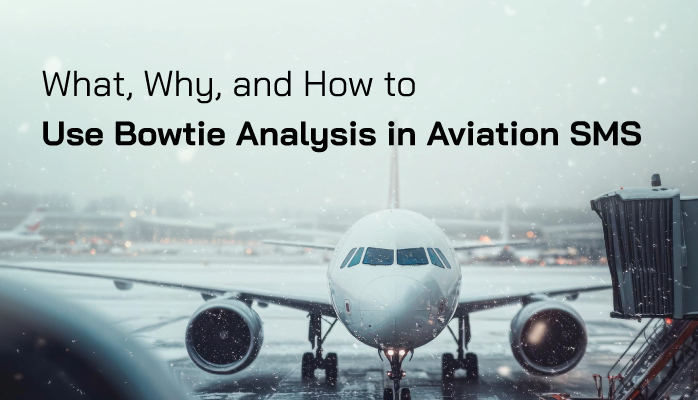What Is Bowtie Analysis in Aviation SMS

Bowtie analysis in aviation safety management systems (SMS) databases is a fairly new tool that is catching on with great success in aviation risk management programs. There are not many SMS databases that have the bowtie, but if you want a great risk management tool seamlessly incorporated into your hazard and risk register, then getting an SMS database with the bowtie is a great choice.
Simply put, the bowtie is one of the most effective risk management tools currently available to aviation safety managers. It ties together previously distinct risk philosophies and tools into a single purpose.
Related Bowtie Analysis in Aviation SMS Articles
- How to Do Bowtie Analysis in Aviation SMS – 5 Step Walkthrough
- 6 Essential Rules for Bowtie Analysis in Aviation SMS
- 4 Best Uses of Bowtie Method in SMS Risk Management – Do You Use Them?
A few critical risk management items that the bowtie incorporates are:
- The James Reason (Swiss Cheese) Model;
- Risk Assessment Charts;
- Leading/lagging indicator analysis;
- Key performance indicators; and
- Performing safety cases.
Using the bowtie will expose all of these elements in one way or another, and it does so in a single, concise visual chart. The bowtie relies on 4 elements to do this (explained more below) which are:
- Root causes that lead to the
- Top Event (i.e., the main issue that arises) that leads to
- Impacts on an organization; and
- The relevant risk controls to the threat/event/impact.
The bowtie will appear different from organization to organization as companies will create bowties that functionally and visually suit their needs best. Some organizations will use a simplified version of the bowtie, and others will use much more complex verbose bowties. They may even appear different each time you use them depending on what your goals are.
Purpose of the Bowtie in Risk Management

The explicit purpose of the bowtie is to show the flow of a safety event including:
- Causes (threats) that aligned to create a problem;
- The events that funneled “upstream” to;
- The Top Event (i.e. the critical point of the event);
- The cascading events of the Top Event that lead “downstream” to;
- Impacts that adversely affect your organization; and
- The failure/success of each risk control measure in the sequence of events.
When a bowtie is conducted in full, it gives a visual picture of the entire issue, from root causes to impacts, including the risk control holes along the way.
The implicit purpose of the bowtie is to expose the important elements of your system, namely key risk indicators, which may also be your key performance indicators (KPIs), and weak controls. Without the bowtie, piecing all of these elements together in a way that shows how they function in context can be difficult and error-prone.
Related Aviation Key Performance Indicators Articles
- How to Automate Key Performance Indicator KPI Monitoring in Aviation SMS
- 5 Tips for Controlling Aviation Key Performance Indicators - With Free KPI Resources
- Tips Using Aviation Key Performance Indicator (KPI) Statistics
Why the Bowtie Is the Best Risk Management Visualization Tool in Existence
Perhaps I am zealous about its potential uses, but I have seen it successfully employed for:
- Teaching employees what risk management is and the role of hazards in an SMS;
- Methodical analysis in safety incident management;
- Documenting preventative analysis in hypothetical scenarios;
- Understanding and assessing your risk controls in context; and
- Identify KPIs
The list goes on, but you get the idea. It is versatile and suited for many uses. Aviation service providers that adopt the bowtie tend to – if they use it right – employ the bowtie with different goals for different uses.
To this end – though I have not seen it done in practice yet – I strongly advise that when you perform a bowtie analysis you should write a “purpose” or “goal” at the top of the bowtie. I recommend this for three reasons:
- Clarifies what you are currently looking for, and therefore what the pertinent information is;
- Great reference point for immediately orienting you when you are looking back at previous bowties; and
- Allows you to create “categories” for organizing bowties.
You could establish ahead of time, for example, 3 or 4 different goals you might have when using bowties. For example, “Hypothetical safety case analysis,” “Safety incident analysis,” “Financial Impact Analysis,” and so on.
3-Step Process for Creating a Bowtie in Aviation SMS

Creating bowties is actually fairly simple as long as you follow the basic process and understand why you are performing it. It goes like this. You have some kind of scenario, real or hypothetical. You need to:
1 - Choose What the Top Event “Loss of Control Incident” Is
This top-level event will be the main “risk” or worst credible "risk scenario" related to:
- hazard in your hazard risk register; or
- in the entire event under analysis, or
- the accident that arose from all the root causes (threats).
For example, this would be the point at which “The driver loses control of the car,” or “The aircraft suddenly loses altitude.”
It’s important not to confuse the Top Event with downstream events or Impacts. Just remember that your Top Event is the point or "incident" at which loss of control occurs.
2 - Ask “But Why” About Top Event to Find Preceding “Upstream” Events and Root Causes
It’s extremely important to make sure your root causes are accurate because the root causes are the threats around which you will create risk controls. Too often people confuse weak controls (e.g. “lack of training” which is actually a weak control) with root causes (better would be “Human Error”).
The best indication that you have arrived at a root cause is that the threat is an ACTIVE verb as opposed to a static, negative “lack of X” or “no Y” noun. Moreover, when you get to a spot where your answer to “But why?” is simply “Because it is,” then you have probably found one root cause. For example, the car lost control. But why? Flat tire. But why? Nail in the road – and there is no answer to this. We found one good root cause: “Road debris.”
3 - Ask “And Then” About Top Event to Find “Downstream” Events and Impacts
To get from your Top Event to impacts, you will want to see the interim events that culminated in the impact. To do this simply ask “And then” about your Top Event and subsequent events. The impacts should be clear when you get there because they are the outcome and “output” of the issue.
Related Articles on Root Causes in Aviation SMS
- How to Conduct Root Cause Analysis in SMS
- 3 Methods for Root Cause Analysis in SMS
- Is Root Cause Analysis Proactive or Reactive?
Final Thought: Bowtie Mistakes to Avoid, Rules to Follow
We spent a lot of time here already, so here are a few tips when conducting bowtie analysis in your aviation SMS:
- Avoid confusing Impacts (issue outcomes) with the Top Event;
- Be explicit rather than implicit with threats, events, and Impacts, which is to say that your bowtie items should state the meaning exactly rather than implying it;
- Make sure root causes are ACTIVE (usually verbs like “Interference of,” “Accumulation of,” and so on);
- Don’t skip over interim events;
- Understand your risk management goal and objectives for implementing risk controls; and
- Use the same step-by-step method (described above) every time you create a bowtie to maintain consistency.
A common data management problem for most aviation SMS under one thousand employees is that their data is scattered across multiple systems, whether they are:
- Paper and MS Excel;
- Excel and MS Access;
- Excel and point solutions; or
- Multiple point solutions that don't talk together.
SMS Pro has all the tools necessary to manage a compliant SMS. Furthermore, you can use the bowtie analysis tools as well as:
- safety reporting system;
- automated email notifications;
- tracking corrective and preventive actions;
- auditing tools, and much more.
To see this aviation SMS database in action, please watch these short demo videos to determine whether we are a good fit for your company.
Live SMS Pro Demo
Have questions or want to see SMS Pro live? Sign up today for a live demo.
Last updated October 2025.








